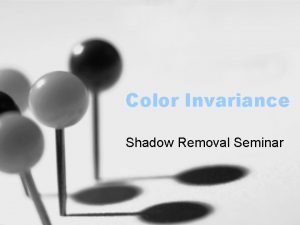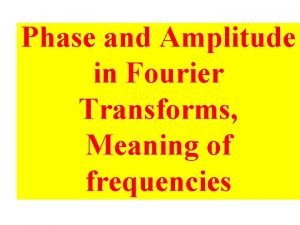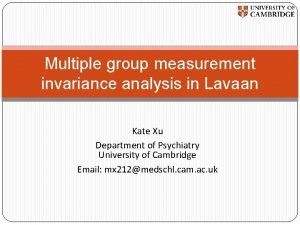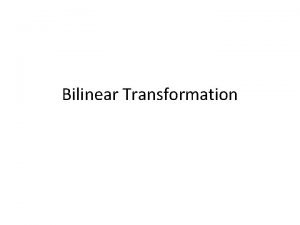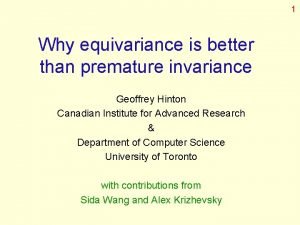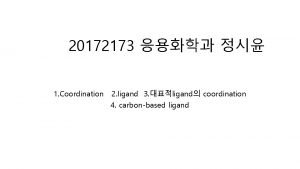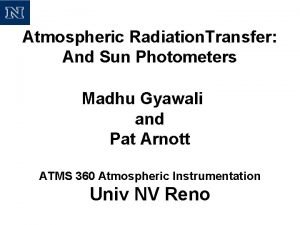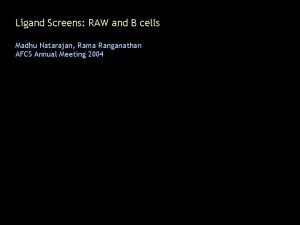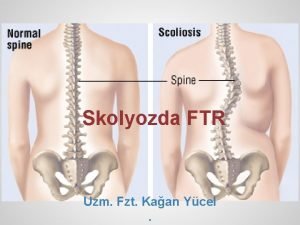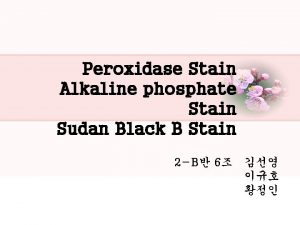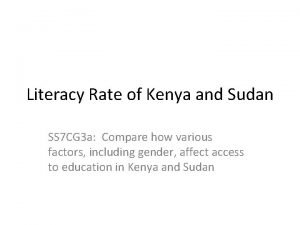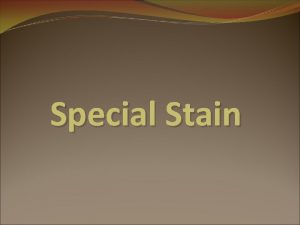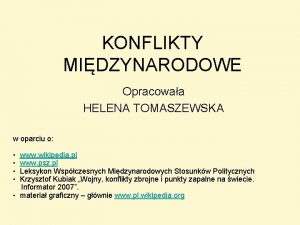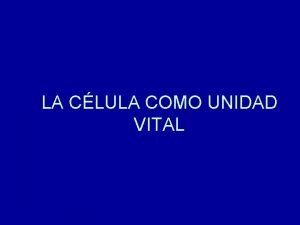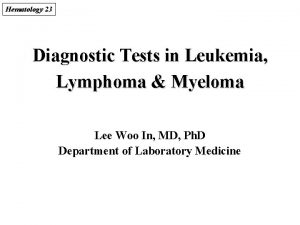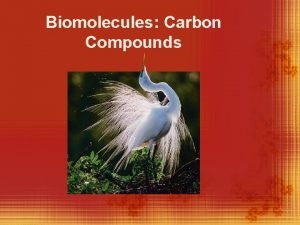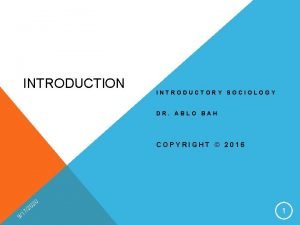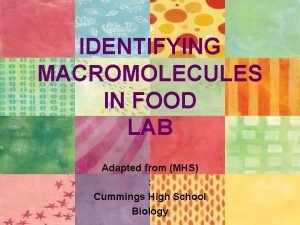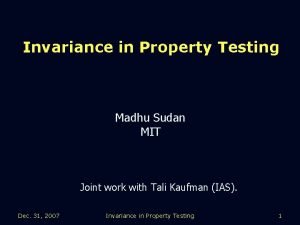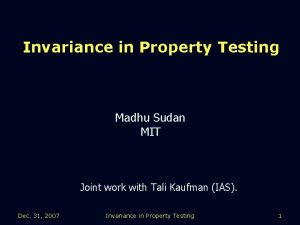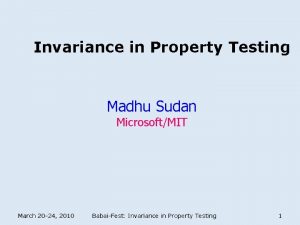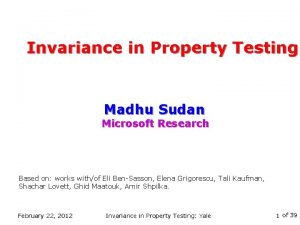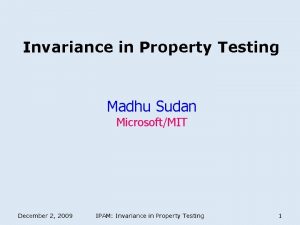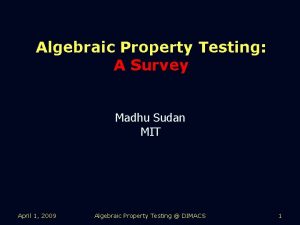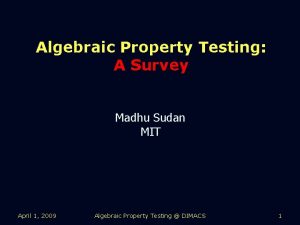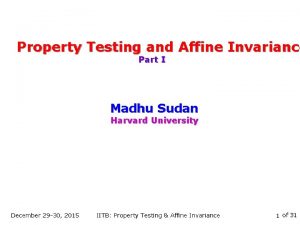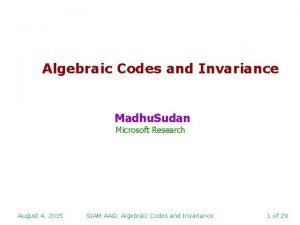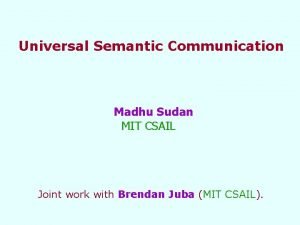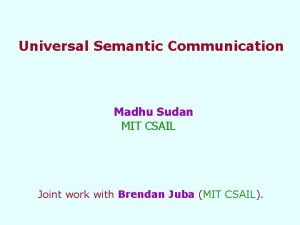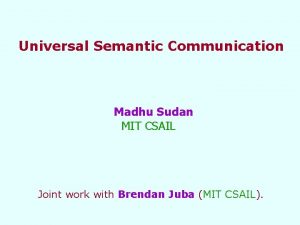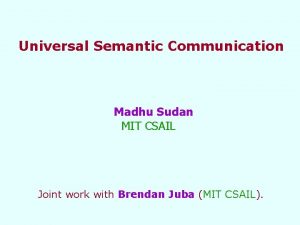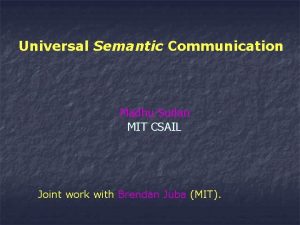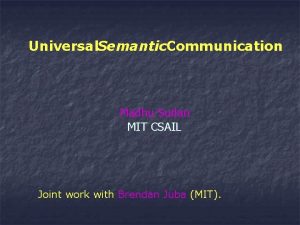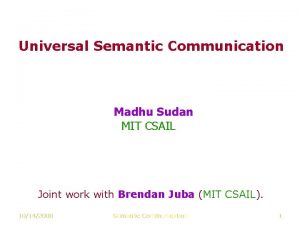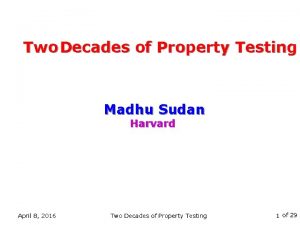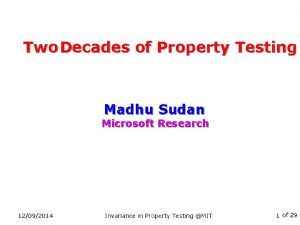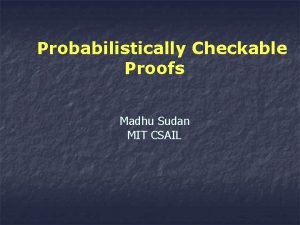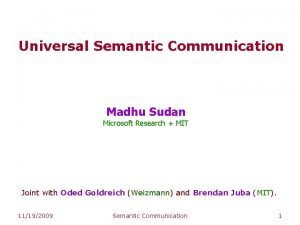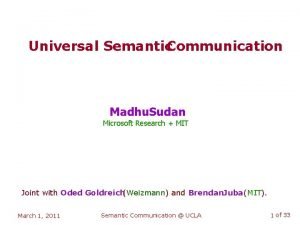Invariance in Property Testing Madhu Sudan MIT Joint


![Property Testing n n 6 g(x)] ±(f ; g) = Pr x 2 D Property Testing n n 6 g(x)] ±(f ; g) = Pr x 2 D](https://slidetodoc.com/presentation_image/6e5cf921ccdef41531f6325941f14271/image-3.jpg)









![Characterizations Sufficient? n NO! [Ben-Sasson, Harsha, Raskhodnikova] n Random 3 -locally characterized errorcorrecting codes Characterizations Sufficient? n NO! [Ben-Sasson, Harsha, Raskhodnikova] n Random 3 -locally characterized errorcorrecting codes](https://slidetodoc.com/presentation_image/6e5cf921ccdef41531f6325941f14271/image-13.jpg)



























- Slides: 40

Invariance in Property Testing Madhu Sudan MIT Joint work with Elena Grigorescu & Tali Kaufman. May 1, 2009 UTA: Invariance in Property Testing 1

Property Testing n n Goal: “Efficiently” determine if some “data” “essentially” satisfies some given “property”. Formalism: f : D ! R given as oracle n Data: D ¯nit e, but huge. R ¯nit e, possibly small n Property: Given by F µ f f : D ! Rg o(D ) queries int o f. Even O(1)! n Efficiently: n Must accept if f 2 F Essentially: Ok t o accept if f ¼ g 2 F. May 1, 2009 UTA: Invariance in Property Testing 2
![Property Testing n n 6 gx f g Pr x 2 D Property Testing n n 6 g(x)] ±(f ; g) = Pr x 2 D](https://slidetodoc.com/presentation_image/6e5cf921ccdef41531f6325941f14271/image-3.jpg)
Property Testing n n 6 g(x)] ±(f ; g) = Pr x 2 D [f (x) = Distance: ±(f ; F ) = ming 2 F f ±(f ; g)g f ¼² g if ±(f ; g) · ². Definition: F is (q; ®) locally t est able if 9 a q query t est er t hat accept s f 2 F wit h probability 1 ¡ ² reject s f 2 6 F wit h probability ¸ ® ¢±(f ; F ). n q locally t est able implies 9® > 0 Notes: locally t est able implies 9 q = O(1) May 1, 2009 UTA: Invariance in Property Testing 3

Property Testing (Pictorially( Universe f f : D ! Rg F Must accept Ok t o accept Must reject w. h. p. May 1, 2009 UTA: Invariance in Property Testing 4

Example: Pre-election Polling n Domain = Population f 0; 1 g Range = F = funct ions wit h majority 1 n Property: n Essentially: n Must reject w. h. p. if Pr x 2 D [f (x) = 1] · 1=2 ¡ ² ~ 2 ) queries. Can t est weakly wit h O(1=² Efficiency? Cherno® bounds. May 1, 2009 UTA: Invariance in Property Testing 5

Modern Day Example: Testing Linearity n Vect or space Fn 2 Domain = Field F 2 Range = n F = linear funct ions Property: i. e. , f f (x) = ha; xi ja 2 Fn 2 g n Theorem [Blum, Luby, Rubinfeld ’ 89]: n Pick x; y 2 Fn 2 uniformly. Test: Accept i® f (x) + f (y) = f (x + y) Linearity is 3 locally t est able. May 1, 2009 UTA: Invariance in Property Testing 6

Property Testing: Abbreviated History n n n Prehistoric: Statistical sampling n E. g. , “Majority = 1? ” Linearity Testing [BLR’ 90], Multilinearity Testing [Babai, Fortnow, Lund ’ 91]. Formal Definition: [Rubinfeld S’ 96] Graph/Combinatorial Property Testing [Goldreich, Goldwasser, Ron ’ 96]. n E. g. , Is a graph “close” to being 3 -colorable. Algebraic Testing [GLRSW, RS, FS, AKKLR, KR, JPSZ] n Is multivariate function a polynomial (of bounded degree). Graph Testing [Alon-Shapira, AFNS, Borgs et al. ] n Characterizes graph properties that are testable. May 1, 2009 UTA: Invariance in Property Testing 7

Quest for this talk n n What makes a property testable? In particular for algebraic properties: n Current understanding: n Low-degree multivariate functions are testable. n Different proofs for different cases. n n May 1, 2009 Linear functions Low-degree polynomials F 2 Higher degree polynomials over other fields UTA: Invariance in Property Testing 8

Contrast w. Combinatorial P. T. Universe (Also usually) R is a ¯eld F Property = Linear subspace. f f : D ! Rg F F Must accept Ok t o accept Must reject w. h. p. Algebraic Property = Code! (usually) May 1, 2009 UTA: Invariance in Property Testing 9

Necessary Conditions for Testability n n n One-sided error and testability: ¡ Suppose f is reject ed by a k query 1 sided t est er. Suppose queried point s are x 1 ; : : : ; x k 2 D. Let f (x i ) = ®i. ¡ T hen for every funct ion g 2 F , 6 h® 1 ; : : : ; ®k i. hg(x 1 ); : : : ; g(x k )i = C = hx 1 ; : : : ; x k i ; S ( R k Constraint: g sat is¯es C if hg(x 1 ); : : : ; g(x k )i 2 S F sat is¯es C if every g 2 F sat is¯es C. Conclusion: Testability implies Constraints. May 1, 2009 UTA: Invariance in Property Testing 10

Necessary Conditions for Testability n n n One-sided error and testability: ¡ Suppose f is reject ed by a k query 1 sided t est er. Suppose queried point s are x 1 ; : : : ; x k 2 D. Let f (x i ) = ®i. ¡ T hen for every funct ion g 2 F , 6 h® 1 ; : : : ; ®k i. hg(x 1 ); : : : ; g(x k )i = C = hx 1 ; : : : ; x k i ; S ( R k Constraint: g sat is¯es C if hg(x 1 ); : : : ; g(x k )i 2 S F sat is¯es C if every g 2 F sat is¯es C. Conclusion: Testability implies Constraints. May 1, 2009 UTA: Invariance in Property Testing 11

Constraints, Characterizations, Testing n n n Strong testing: 6 F reject ed Every f 2 by some k local const raint. Set of k local const raint s charact erize F. 9 C 1 ; : : : ; Cm s. t. f 2 F , f sat is¯es Cj for every j. Conclusion: Testability ⇒ Local Characterizations. Example: f µ f Fn 2 ! F 2 g is linear i® for all x; y 2 Fn 2 , f sat is¯es Cx ; y where Cx ; y = hx; y; x + yi ; S = f 000; 011; 101; 110 g. May 1, 2009 UTA: Invariance in Property Testing 12
![Characterizations Sufficient n NO BenSasson Harsha Raskhodnikova n Random 3 locally characterized errorcorrecting codes Characterizations Sufficient? n NO! [Ben-Sasson, Harsha, Raskhodnikova] n Random 3 -locally characterized errorcorrecting codes](https://slidetodoc.com/presentation_image/6e5cf921ccdef41531f6325941f14271/image-13.jpg)
Characterizations Sufficient? n NO! [Ben-Sasson, Harsha, Raskhodnikova] n Random 3 -locally characterized errorcorrecting codes (“Expander Codes”) are not o(D)-locally testable. n Property: D = [n]; R = f 0; 1 g; F = set of funct ions t hat sat isfy some random 3 ary F 2 linear const raint s. n n Criticism: Random constraints too “asymmetric”. Perhaps should consider more “symmetric” properties. May 1, 2009 UTA: Invariance in Property Testing 13

Invariance & Property testing n n Invariances (Automorphism groups): For permut at ion ¼: D ! D , F is ¼ invariant if f 2 F implies f ± ¼ 2 F. Aut (F ) = f ¼ j F is ¼ invariant g Forms group under composit ion. Hope: If Automorphism group is “large” (or “nice”), then property is testable. May 1, 2009 UTA: Invariance in Property Testing 14

Examples n Majority: ¡ Aut group = SD (full group). ¡ Easy Fact : If Aut (F ) = SD t hen F is poly(R; 1=²) locally t est able. n Graph Properties: ¡ Aut. group given by renaming of vert ices ¡ [AFNS, Borgs et al. ] implies regular propert ies wit h t his Aut group are t est able. n n Statistical Properties: Closed under every permutation of domain and range. Algebraic Properties: What symmetries do they have? Will focus on this today. May 1, 2009 UTA: Invariance in Property Testing 15

Algebraic Properties & Invariances n Properties: D = Fn , R = F (Linearity, Low degree, Reed Muller) Or D = K ¶ F, R = F (Dual BCH) (K ; F ¯nit e ¯elds) n Automorphism groups? n (Linear-Invariant) Additional restriction: Linearity n Linear t ransformat ions of domain. ¼(x) = Ax where A 2 Fn £ n f ; g 2 F and ®; ¯ 2 F implies ®f + ¯g 2 F Question: Are Linear, Linear-Invariant, Locally Characterized Properties Testable? May 1, 2009 UTA: Invariance in Property Testing 16

Linear-Invariance & Testability n Question: Are Linear, Linear-Invariant, Locally Characterized Properties Testable? n Why? n Unifies previous results on Prop. Testing. n (Will show it also is non-trivial extension) n Nice family of 2 -transitive group of symmetries. n Conjecture [Alon, Kaufman, Krivelevich, Litsyn, Ron] : Linear code with k-local constraint and 2 transitive group of symmetries must be testable. May 1, 2009 UTA: Invariance in Property Testing 17

Our Results n n n F µ f K n ! Fg linear, linear invariant , Theorem 1: k locally charact erized implies F is f (K ; k) locally t est able. F µ f K n ! Fg linear, a± ne invariant , Theorem 2: has k local constraint implies F is f (K ; k) locally t est able. Other stuff: n Study of Linear-invariant Properties. n Counterexample to AKKLR conjecture. May 1, 2009 UTA: Invariance in Property Testing 18

Linear Invariant Properties May 1, 2009 UTA: Invariance in Property Testing 19

Examples of Linear-Invariant Families ¡ Polynomials in F[x 1 ; : : : ; x n ] of degree at most d ¡ Traces of Poly in K [x 1 ; : : : ; x n ] of degree at most d ¡ (Traces of ) Homogenous polynomials of degree d ¡ F 1 + F 2 , where F 1 , F 2 are linear invariant. Polynomials support ed by degree 2; 3; 5; 7 monomials. May 1, 2009 UTA: Invariance in Property Testing 20

What Dictates Locality of Characterizations? ¡ Precise locality not yet underst ood: Depends on p ary represent at ion of degrees. Example: F support ed by monomials x pi + pj behaves like degree two polynomial ¡ For a± ne invariant family dict at ed (coarsely) by highest degree monomial in family ¡ For some linear invariant families, can be much less t han t he highest degree monomial. Example: K = F 7 ; F = F 1 + F 2 F 1 = poly of degree at most 16 F 2 = poly support ed on monomials of degree 3 mod 6. Degree(F ) = (n); Locality(F ) · 49. May 1, 2009 UTA: Invariance in Property Testing 21

Analysis Ingredients n Monomial Extraction: n Monomial Spread: E. g. , xy 2 + xyz + x 4 2 F implies xyz 2 F x 5 2 F implies x 4 y; x 3 y 2 also in F (if char(F) large) Su± ces for a± ne invariant families. For linear invariant families, need t o de¯ne t he right paramet er and bound locality weakly in t erms of it. May 1, 2009 UTA: Invariance in Property Testing 22

Local Testing May 1, 2009 UTA: Invariance in Property Testing 23

Key Notion: Single Orbit Property ¡ F has single orbit property if 9 a single const raint C = (hx 1 ; : : : ; x k i ; S) such t hat f C ± ¼g¼ 2 A ut ( F ) charact erize F. ¡ Single orbit property applies t o all known algebraic propert ies, possibly wit h t he except ion of BCH codes. T heorem: Every linear invariant F wit h a k local charact erizat ion, has t he single orbit property under some f (k; K ) local const raint T heorem: If F has single orbit property wit h a k local const raint (wit h some rest rict ions) t hen it is k locally t est able. May 1, 2009 UTA: Invariance in Property Testing 24

BLR (and our) analysis May 1, 2009 UTA: Invariance in Property Testing 25

The tests n Pick x; y 2 R Fn and check BLR: f (x) + f (y) = f (x + y) Need t o show: 9 g s. t. ±(f ; g) · C ¢Pr x ; y [f (x) + f (y) = 6 f (x + y)] n Ours: F given by x 1 ; : : : ; x k ; V Pick linear/ a± ne L : K n ! K n at random Verify hf (L (x 1 )); : : : ; f (L (x k ))i 2 V Need t o show 9 g 2 F s. t. 2 V ±(f ; g) · C ¢Pr L [hf (L (x 1 )); : : : ; f (L (x k ))i 6 May 1, 2009 UTA: Invariance in Property Testing 26

BLR Analysis: Outline ² Have f s. t. Pr x ; y [f (x) + f (y) = 6 f (x + y)] = ± < 1=20. Want t o show f close t o some g 2 F. ² De¯ne g(x) = most likely f f (x + y) ¡ f (y)g. y ² If f close t o F t hen g will be in F and close t o f. ² But if f not close? g may not even be uniquely de¯ned! ² St eps: ¡ St ep 0: Prove f close t o g ¡ St ep 1: Prove most likely is overwhelming majority. ¡ St ep 2: Prove t hat g is in F. May 1, 2009 UTA: Invariance in Property Testing 27

BLR Analysis: Step 0 ² De¯ne g(x) = most likely y f f (x + y) ¡ f (y)g. = g(x)] · 2± Claim: Pr x [f (x) 6 = f (x + y) ¡ f (y)] ¸ ¡ Let B = f xj Pr y [f (x) 6 ¡ Pr x ; y [linearity t est reject s jx 2 B ] ¸ 1 g 2 1 2 ) Pr x [x 2 B ] · 2± ¡ If x 2 6 B t hen f (x) = g(x) May 1, 2009 UTA: Invariance in Property Testing 28

Vot ex (y) BLR Analysis: Step 1 ² De¯ne g(x) = most likely y f f (x + y) ¡ f (y)g. ² Suppose for some x, 9 two equally likely values. Presumably, only one leads t o linear x, so which one? ² If we wish t o show g linear, t hen need t o rule out t his case. Lemma: 8 x, Pr y ; z [Vot ex (y) = 6 Vot ex (z))] · 4± May 1, 2009 UTA: Invariance in Property Testing 29

Vot ex (y) BLR Analysis: Step 1 ² De¯ne g(x) = most likely y f f (x + y) ¡ f (y)g. ² Suppose for some x, 9 two equally likely values. Presumably, only one leads t o linear x, so which one? ² If we wish t o show g linear, t hen need t o rule out t his case. Lemma: 8 x, Pr y ; z [Vot ex (y) = 6 Vot ex (z))] · 4± May 1, 2009 UTA: Invariance in Property Testing 30

Vot ex (y) BLR Analysis: Step 1 ² De¯ne g(x) = most likely y f f (x + y) ¡ f (y)g. = Vot ex (z))] · 4± Lemma: 8 x, Pr y ; z [Vot ex (y) 6 ? f (z) f (y) ¡ f (x + y) f (y + z) ¡ f (y + 2 z) ¡ f (x + z) ¡ f (2 y + z) f (x + 2 y + 2 z) Prob. Row/ column sum non zero · ±. May 1, 2009 UTA: Invariance in Property Testing 31

Vot ex (y) BLR Analysis: Step 1 ² De¯ne g(x) = most likely y f f (x + y) ¡ f (y)g. = Vot ex (z))] · 4± Lemma: 8 x, Pr y ; z [Vot ex (y) 6 ? f (z) f (y) ¡ f (x + y) f (y + z) ¡ f (y + 2 z) ¡ f (x + z) ¡ f (2 y + z) f (x + 2 y + 2 z) Prob. Row/ column sum non zero · ±. May 1, 2009 UTA: Invariance in Property Testing 32

BLR Analysis: Step 2 (Similar( Lemma: If ± < g(x) f (z) 1 , 20 t hen 8 x; y, g(x) + g(y) = g(x + y) g(y) ¡ g(x + y) Prob. Row/ column sum non zero · 4±. f (y + z) ¡ f (y + 2 z) ¡ f (x + z) ¡ f (2 y + z) f (x + 2 y + 2 z) May 1, 2009 UTA: Invariance in Property Testing 33

Our Analysis: Outline ² f s. t. Pr L [hf (L (x 1 ); : : : ; f (L (x k ))i 2 V ] = ± ¿ 1. ² De¯ne g(x) = ® t hat maximizes Pr f L j L ( x ) = x g [h®; f (L (x 2 )); : : : ; f (L (x k ))i 2 V ] 1 ² St eps: ¡ St ep 0: Prove f close t o g ¡ Step 1: Prove “most likely” is overwhelming majority. ¡ St ep 2: Prove t hat g is in F. May 1, 2009 UTA: Invariance in Property Testing 34

Our Analysis: Outline ² f s. t. Pr L [hf (L (x 1 ); : : : ; f (L (x k ))i 2 V ] = ± ¿ 1. ² De¯ne g(x) = ® t hat maximizes Pr f L j L ( x ) = x g [h®; f (L (x 2 )); : : : ; f (L (x k ))i 2 V ] 1 Same as before ² St eps: ¡ St ep 0: Prove f close t o g ¡ Step 1: Prove “most likely” is overwhelming majority. ¡ St ep 2: Prove t hat g is in F. May 1, 2009 UTA: Invariance in Property Testing 35

Vot ex (L ) Matrix ? ² De¯ne Magic g(x) = ® t hat maximizes Pr f L j L ( x = 1) xg [h®; f (L (x 2 )); : : : ; f (L (x k ))i 2 V ] 6 Vot ex (K ))] · 2(k ¡ 1)± Lemma: 8 x, Pr L ; K [Vot ex (L ) = x K (x 2 ). . . L (x 2 ) ? ¢¢¢ L (x k ) K (x k ) May 1, 2009 UTA: Invariance in Property Testing 36

Matrix Magic? x K (x 2 ). . . L (x 2 ) ? ¢¢¢ L (x k ) K (x k ) ² Want marked rows t o be random const raint s. ² Suppose x 1 ; : : : ; x ` linearly independent ; and rest dependent on t hem.

Matrix Magic? n ` x ` L (x 2 ) Fill with random entries n n ¢¢¢ Fill so as to form constraints Linear algebra implies final columns are also constraints. L (x k ) K (x 2 ). . . K (x k ) ² Suppose x 1 ; : : : ; x ` linearly independent ; and rest dependent on t hem.

Matrix Magic? n ` x ` L (x 2 ) Fill with random entries n n ¢¢¢ Fill so as to form constraints Linear algebra implies final columns are also constraints. L (x k ) K (x 2 ). . . K (x k ) ² Suppose x 1 ; : : : ; x ` linearly independent ; and rest dependent on t hem.

Conclusions n n n Invariance is important in property testing. Linear-invariance suffices to explain many algebraic tests (and shows some new ones. ( Future work: What are other invariances that lead to testability (from characterizations? ( May 1, 2009 UTA: Invariance in Property Testing 40
 Invariance property
Invariance property Phase invariance
Phase invariance Lavaan measurement invariance
Lavaan measurement invariance Bilinear transformation and impulse invariance
Bilinear transformation and impulse invariance Equivariance vs invariance
Equivariance vs invariance Madhu natarajan
Madhu natarajan Acharyamarch
Acharyamarch Madhu gyawali
Madhu gyawali Justice for madhu
Justice for madhu Madhu natarajan
Madhu natarajan Fonksiyonel skolyoz
Fonksiyonel skolyoz Myeloperoxidase staining
Myeloperoxidase staining History of nursing in sudan
History of nursing in sudan Kenya literacy rate
Kenya literacy rate Karanlık gecede kara sudan zap suyuna giden yol
Karanlık gecede kara sudan zap suyuna giden yol Sudanese electricity distribution company
Sudanese electricity distribution company Leukomoid reaction
Leukomoid reaction Jugosławia na co się rozpadła
Jugosławia na co się rozpadła Ust sudan
Ust sudan Inso south sudan
Inso south sudan Ameba es unicelular o pluricelular
Ameba es unicelular o pluricelular Sudan black
Sudan black Sudan çıkma egzersizi
Sudan çıkma egzersizi Sudan iii indicator biomolecules
Sudan iii indicator biomolecules National audit chamber sudan
National audit chamber sudan Winwin south sudan
Winwin south sudan In sudan
In sudan Iki indicator
Iki indicator Composition sudanese hospitality
Composition sudanese hospitality Associative property vs commutative property
Associative property vs commutative property Sapratibandha
Sapratibandha Chemical property definition
Chemical property definition Jppso southeast
Jppso southeast Lamb quality grades
Lamb quality grades What cartilage is found between the vertebrae
What cartilage is found between the vertebrae Permanent joint examples
Permanent joint examples Joint venture accounting journal entries
Joint venture accounting journal entries Lamb grading chart
Lamb grading chart Ellipsoid joint
Ellipsoid joint What is domain test
What is domain test Logic based testing in software testing
Logic based testing in software testing
